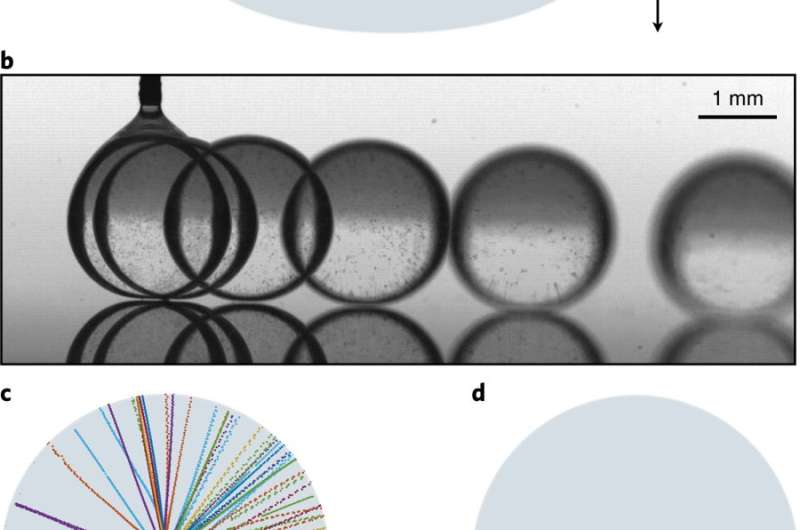September 12, 2018 report
Leidenfrost effect drops found to be self-propelled

A team of researchers at Physique et Mécanique des Milieux Hétérogènes in France has found that Leidenfrost effect drops move around on a hot pan because they are self-propelled. In their paper published in the journal Nature Physics, the group describes their study of the drops and what they found.
When drops of water land on a hot surface they begin moving around in the pan like a hockey puck on ice. Prior research has shown the slipperiness of the drops is due to a thin layer of steam that is created between the drop and the pan—causing the drop to be levitated. As to why the drop moves without prompting, prior researchers have suggested it is due to slight bits of air movement or gravity acting on them. In this new effort, the researchers have found that there is another force involved.
To find out why the drops move without apparent cause, the researchers set up an experiment that involved placing a pan on a hot plate surrounded by high-speed cameras which were attached to motion-tracking software. To find out what goes on inside of the droplets, the group injected tiny glass spheres into a small sample of water which was used for generating droplets.
In examining the results on their computer screen, the researchers found that larger drops behaved as expected—the glass spheres flowed in a smooth manner and the drops on the hot plate hardly moved. But as the drops on the pan grew smaller due to evaporation, they flattened out and the flow inside of the drops became unbalanced—the unbalance caused the drop to move forward.
The researchers also found that the unbalance inside the drop caused the drop to tilt downwards in the same direction that the drop was moving—sort of like a miniature tidal wave. That tilt, they note, worked like a ratchet to keep the drop moving until the drop evaporated completely. They also noted that the drops tended to roll towards a cooler part of the heated surface, suggesting that their movement might be controllable. If so, that could lead to a new type of self-propelled devices.
More information: Ambre Bouillant et al. Leidenfrost wheels, Nature Physics (2018). DOI: 10.1038/s41567-018-0275-9
Abstract
As reported in 1756 by Johann Gottlob Leidenfrost, volatile liquids on hot solids form "gleaming drops resembling quicksilver", a consequence of their levitation on a vapour cushion. This makes the drops spectacularly mobile, moving away as soon as they are deposited—an observation commonly attributed to gravity or surrounding airflows. This mobility has been exploited to manipulate drops, because tiny forces such as those generated on asymmetric substrates can move them in well-defined directions, a situation that also provides heat evacuation. Here we report that Leidenfrost droplets initially at rest on horizontal substrates self-rotate and self-propel in the direction they are rolling, in the absence of any source of asymmetry or external force. Their rapid internal flow is found to be accompanied by a tilting of their base, which creates a permanent ratchet-like mechanism, entraining the rolling liquid despite the fact that it is not in contact with its substrate.
Journal information: Nature Physics
© 2018 Phys.org


















